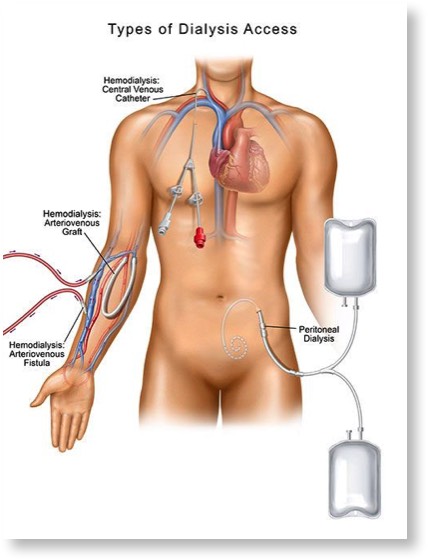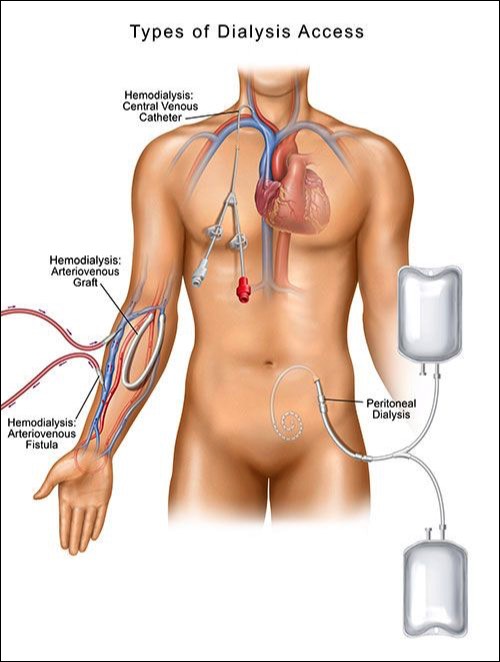-
Renal Failure and Dialysis
Two basic functions of the kidneys are to cleanse the body of waste products, and to regulate the amount of water and certain chemicals in your blood. If your kidneys fail, unless and until you have a successful kidney transplant, you will need dialysis therapy to clean and filter your blood. The first step is establishing dialysis access one of four ways:

1. A tunneled catheter in your neck. This is usually temporary, because the possibility of infection is high.
2. An AV fistula. This involves taking a piece of a vein from your arm or leg and sewing it into a nearby artery, and allowing the sewn-in vein to enlarge and become thicker, like an artery. This procedure is considered the best option because it has the lowest risk of infection.
3. An AV graft. This procedure involves the sewing of a prosthetic graft between an artery and vein in your arm or leg. This is the preferred option if your veins are too small for an AV fistula. AV grafts tend to close more quickly and are more prone to infection because they are not formed from natural tissue.
4. Peritoneal dialysis. Peritoneal dialysis involves the placement of a small tube, called a cannula, in your abdomen to allow the use of the lining of the abdomen (peritoneum) to filter your blood. It requires several “exchanges” every day: you introduce and remove fluid through the tube. A convenient option because you perform the dialysis therapy at home, but infections sometimes occur and the tube can become clogged.
-
Why it's Done
When your kidneys fail, your body is unable to clean and filter your blood. Electrolyte levels, such as potassium and phosphorous, can become dangerously high. When kidney function falls below a certain threshold, dialysis is needed.
If it appears that dialysis will be needed in the future, it’s time to establish dialysis access, ideally with one of the three permanent methods described above (option 2, 3 or 4). -
Preparing for Surgery for Fistulas and Grafts
Your dialysis access surgeon will perform a physical exam, focusing on the arm or leg selected, usually your non-dominant arm. Typically, an ultrasound scan is used to “map” your veins to see if they are large enough for an AV fistula. If not, an AV graft will be needed.
Fast (no food or drink) for 8 hours prior to the procedure, unless your operating team directs otherwise.
Anesthesia
Most vascular access procedures can be performed on an outpatient basis, under conscious sedation. The anesthesiologist may administer some sedative medication to allow the patient to be relaxed and drowsy, but general anesthesia is usually not required. Patients will remain in the hospital for one to two hours after surgery.
Procedure
In the operating room, your arm or leg is cleansed with an antiseptic solution and sterile drapes are placed around it. An incision is made between the artery and vein, and the vessels to be joined are prepared.
If creating a fistula, your surgeon may divide the vein and sew one end to the side of the artery, or may sew the two vessels side-to-side without dividing the vein.
If a graft will be placed, your surgeon will sew it between the artery and vein. The incision in your arm or leg will be closed and a sterile dressing will be applied.
Bleeding is the most common complication. Generally, this is noticed and taken care of before you go home.
What Can I Expect After Treament- The vein will enlarge and it should be easy to feel a vibration.
- Avoid sleeping on the affected arm or leg
- Avoid constrictive clothing over the site.
- Once you begin dialysis, inspect the access site regularly for bleeding or signs of infection, such as redness or warmth.
Contact Your Dialysis Surgeon Immediately If…
- You notice swelling or your dressing becomes saturated.
- Your hand or leg becomes very cold or numb as this may indicate a serious problem (“steal syndrome”) that may need urgent attention.
- Slight coolness in the affected hand or leg is common. This happens because some of the blood that was supplying the hand or leg is being redirected. Squeezing an old tennis ball or racquetball in your hand can help your body re-adjust.
- Vibration changes or pulsations. When you place your hand over the fistula or graft, you should feel a vibration. If the vibration stops or becomes a pulsation, contact your surgeon, as the change may indicate that the access has narrowed
- You will be asked to avoid having blood drawn from veins in the selected arm or leg. This is sometimes referred to as “preserving the veins.”
-
Preparing for Surgery for Peritoneal Dialysis Catheter
Peritoneal dialysis uses the thin membrane called the peritoneum, which lines the abdomen. During treatments a cleansing fluid called a dialysate is put into the patient’s abdomen through a small flexible tube, called a PD catheter.
Anesthesia
Peritoneal catheter surgery is a laparoscopic surgery and is done in a hospital setting, under general anesthesia. You won’t be able to eat or drink anything after midnight the day of your surgery.
Procedure
The nurse or doctor will draw on your skin with a marker to show where the catheter will go. The surgeon will make about 2-3 small incisions in your abdomen. A port (nozzle) is inserted into one of the slits, and carbon dioxide gas inflates the abdomen. This process allows the surgeon to see inside of your abdomen more easily. A laparoscope is inserted through another port. The laparoscope looks like a telescope with a light and camera on the end so the surgeon can see inside the abdomen. Surgical instruments are placed in the other small openings and used to place the peritoneal dialysis catheter into your abdominal cavity. The catheter will exit out of your skin. After the catheter has been placed, the carbon dioxide is released out of the abdomen through the slits, and then these sites are closed with sutures or staples, or covered with glue-like bandages and steri-strips.
What Can I Expect After Treatment?
Most people say they don’t feel much pain after having a PD catheter placed, but if you experience pain, your surgeon will prescribe medication. If you had general anesthesia, you may feel groggy. Since you don’t know how you will feel, plan to take it easy for a few days so you can heal.
PD fluid may be put in your belly when a catheter is placed. If so, some may drain out and soak the bandages. You should get clean, dry gauze and tape to take home just in case. Your belly may also feel tight if fluid was left in. This will ease over time. In most cases, your PD training nurse will want to change the dressings. This gives him or her a chance to check on your healing. You will be trained by your PD nurse on how to perform your dialysis.Contact Your Dialysis Surgeon Immediately If…
- You have redness or swelling at the exit site
- Pain in your abdomen or near your ribs
- Cloudy fluid
- Inability to perform your treatment due to a clogged catheter




